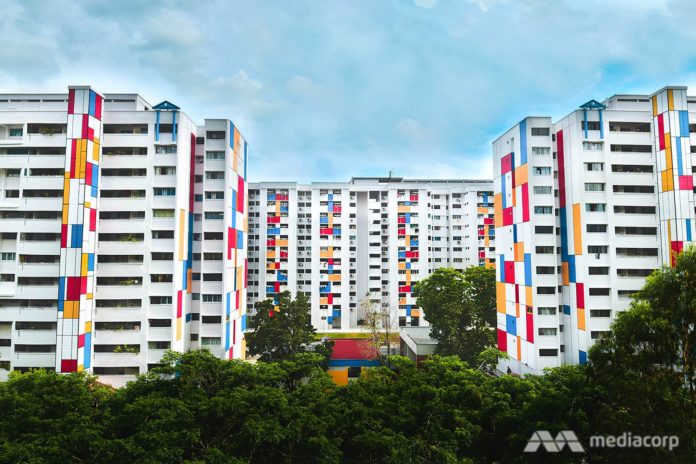SINGAPORE: Ever wondered how much of your hard-earned money you should be spending on rental? Here are some basic guidelines – be it for condominiums or HDB properties.
TYPICAL CONDO RENT PRICES
If you’re completely new to Singapore, here are some very rough, easy numbers to go by when calculating how much to spend on rent.
- Core Central Region (CCR) and Sentosa – About S$5,000 to S$8,000 per month
- Rest of Central Region (RCR) – About S$3,500 to S$4,200 per month
- Outside of Central Region (OCR) – About S$2,100 to S$2,600 per month
Mind you, there are always exceptions. You’ll occasionally see a unit that’s twice the average rental amount. That may happen if it’s near a hub area (for example, near Toa Payoh Central), or has some kind of unique amenity; proximity to certain universities, being next to the MRT station, and so forth.
READ: 5 common mistakes Singaporeans make when upgrading to a condominium

Teck Whye Avenue decked out in red, blue and yellow. (Photo: Gaya Chandramohan)
RENTING HDB FLATS
If a flat is at least a three-room, the owner can let out individual rooms. These are the most affordable options, and prices can be in the range of S$550 to S$1,200 depending on location.
As for renting out the entire flat, HDB prices are (currently) almost on par with condo prices in the OCR. This is because Singapore’s rental market has softened considerably over the past three years. In the more central and mature districts, HDB flats can rent out for around S$3,000 a month.
But again, note that this is due to unusually low rental rates for condos in the market right now; the price gap between condos and HDB flats is historically much greater.
So now that you have a baseline, here are the other considerations when you spend on rent:
- Use the 40 per cent expense ratio guideline
- Check the rates of neighbouring units
- Get a lower price for a longer lease
- Work out furnishing costs before picking a rental unit
1. Use the 40% expense ratio guideline
This is one of those financial rules of thumb, like saving 20 per cent of your pay cheque. If you’re faced with the choice of choosing between two shortlisted units, you can pay less attention to the price difference if it falls within the realm of affordability.
For example, say you have a monthly income of S$7,500. You would then budget a maximum of S$3,000 a month to spend on rent. Between a unit that costs S$2,600 a month, and a unit that costs S$3,000 a month, you’ll know you’re “safe” picking the more expensive unit. It still falls within the realm of affordability.
As to why 40 per cent, that’s because it still allows you to save and have decent discretionary income.
In the case of S$7,500, you could still save S$1,500 a month for emergencies, and have S$3,000 a month to spend on scented candles, string quartet concerts, and other fancy things.
READ: Tenant tips: 7 effective steps to negotiating rent in Singapore
2. Check the rates of neighbouring units
So you’ve found a unit you like, because the condo has a nice pool. Before you sign on the dotted line, check to see if there are other available units in the same development.
It should go without saying, but plenty of over-eager first-time renters miss this step. Doing so, however, could get you a better deal.
We don’t just mean look at their listings; we mean speak to the agent or landlord, and try to negotiate with them as well.
In fact, let them know you’re talking to them because you’re interested in another unit in the same condo (some competition always helps to lower the price).
Besides potentially getting you a good deal, this ensures you’re not overpaying for your unit of choice.
If all the surrounding units are being rented for S$3,000 a month, you don’t want to be only person who ends up paying S$3,300; at least not without a fantastic reason.
READ: Renting a home when you have kids: What to look out for
3. Get a lower price for a longer lease
If you want a two- or three-year lease, don’t let the cat out of the bag early. When asked, say you’ll be here for a while but may consider moving once you understand the island better.
And then ask if you can get a lower price if you sign a longer lease. Having a property empty for even one month can be costly to the landlord, so most are eager to minimise vacancies. You may be able to bargain the price down by 10 to 15 per cent by taking a longer lease.
File photo. (Photo: Unsplash)
4. Work out furnishing costs before picking a rental unit
Before you even go shopping for a unit, note the floor space you want. Then drop by IKEA or these furniture stores, and work out the cost of furnishings you need.
This will help you decide between a furnished and unfurnished unit. If the added cost of buying your own stuff takes you beyond the 40 per cent guideline (see point 1), then you may want to look for something else.
A common newbie mistake when you spend on rent is to make off-the-cuff decisions about whether the unit must be furnished, and then rack up a massive credit card bill when the furniture costs more than they suspected.
So remember: work out the estimated cost of furnishings first. That will help you gauge how much you should be paying for rental costs alone.
This article first appeared on 99.co.





